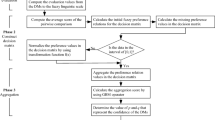Abstract
Quality of life evaluation is important in national goal setting, program benefit evaluation, and priority ranking of resource allocation. However, the relationship between individual measures and overall evaluation of the quality of life is highly complex. The effectiveness of integrating fuzzy-connective-based aggregation network with real-valued genetic algorithm (GA) in quality of life evaluation is investigated. The fuzzy-connective-based aggregation network aggregates the relative status or achievement among states in quality of life-related variables through a hierarchical decision-making structure. The aggregation network then produces an overall quality of life evaluation from various aspects. Integration with real-valued GA helps avoid stopping at local solutions, as experienced by conventional fuzzy-connective-based aggregation networks. The drawbacks in binary GA are also prevented. The effectiveness and applicability of integrating fuzzy-connective-based aggregation networks with real-valued GA for quality of life evaluation is confirmed through statistical analysis.








Similar content being viewed by others
References
Chang CA, Su CT (1995) A comparison of statistical regression and neural network methods in modeling measurement errors for computer vision inspection systems. Comput Ind Eng 28:593–603
Grabisch M, Marichal JL, Mesiar R, Pap E (1992) Aggregation functions. Cambridge University Press, New York
Chiang JH, Chen YC (2002) Incorporating fuzzy operators in the decision network to improve classification reliability. Comput Electr Eng 28:547–560
Krishnapuram R, Lee J (1992) Fuzzy-connective-based hierarchical aggregation networks for decision making. Fuzzy Set Syst 46:11–27
Krishnapuram R, Lee J (1992) Fuzzy-set-based hierarchical networks for information fusion in computer vision. Neural Netw 5:335–350
Torra V (2003) Information fusion in data mining. Springer, New York
Sexton RS, Dorsey RE, Johnson JD (1998) Toward global optimization of neural networks: a comparison of the genetic algorithm and backpropagation. Decis Support Syst 22:171–185
Venkatesan D, Kannan K, Saravanan R (2009) A genetic algorithm-based artificial neural network model for the optimization of machining processes. Neural Comput Appl 18:135–140
Liang YH (2009) Combining seasonal time series ARIMA method and neural networks with genetic algorithms for predicting the production value of the mechanical industry in Taiwan. Neural Comput Appl 18:833–841
Leung KF, Leung FHF, Lam HK, Ling SH (2007) Application of a modified neural fuzzy network and an improved genetic algorithm to speech recognition. Neural Comput Appl 16:419–431
Wu CH, Tzeng GH, Goo YJ, Fang WC (2007) A real-valued genetic algorithm to optimize the parameters of support vector machine for predicting bankruptcy. Expert Syst Appl 32:397–408
Pan WT (2009) Forecasting classification of operating performance of enterprises by ZSCORE combining ANFIS and genetic algorithm. Neural Comput Appl 18:1005–1011
Dyckhoff H, Pedrycz W (1984) Generalized means as a model of compensation connectives. Fuzzy Set Syst 14:143–154
Zimmermann HJ, Zysno P (1980) Latent connectives in human decision making. Fuzzy Set Syst 4:37–51
Rumelhart DE, McClelland JM, the PDP Research Group (1986) Parallel distributed processing. The MIT Press, Cambridge
Zimmermann HJ, Zysno P (1983) Decision and evaluations by hierarchical aggregation of information. Fuzzy Set Syst 10:243–260
Zimmermann HJ (1991) Fuzzy set theory and its applications, 2nd edn. Maw Chang Book Company, Taipei
Goldberg DE (1989) Genetic algorithms in search, optimization and machine learning. Addison-Wesley, New York
Holland JH (1975) Adaption in natural and artificial systems. The University of Michigan Press, Ann Arbor
Herrera F, Lozano M, Verdegay JL (1998) Tackling real-coded genetic algorithms: operators and tools for behavioral analysis. Artif Intell Rev 12:265–319
Dorsey RE, Mayer WJ (1995) Genetic algorithms for estimation problems with multiple optima, nondifferentiability, and other irregular features. J Bus Econ Stat 13(1):53–66
Su MC, Chang HT (2000) Application of neural networks incorporated with real-valued genetic algorithms in knowledge acquisition. Fuzzy Set Syst 112:85–97
Haupt RL, Haupt SE (2004) Practical genetic algorithms, 2nd edn. Wiley, New Jersey
Sivanandam SN, Deepa SN (2008) Introduction to genetic algorithms. Springer, New York
Wright AH (1991) Genetic algorithms for real parameter optimization. In: Rawlin GJE (ed) Foundations of genetic algorithms. Morgan Kaufmann, San Mateo, pp 205–218
Michalewicz Z (1992) Genetic algorithms + data structures = evolution programs. Springer, New York
De Jong KA (1975) An analysis of the behavior of a class of genetic adaptive systems. Dissertation, University of Michigan
Liu BC (1988) Energy, income, and quality of life management in USA: an information systems approach to decision analysis. Tamkang University, Taipei
Herrera EW, Islam G, Hamilton M (2009) Subjective well-being in cities: a multidimensional concept of individual, social and cultural variables. Appl Res Qual Life 4:201–221
Cracolici MF, Giambona F, Cuffaro M (2011) The determinants of subjective economic well-being: an analysis on Italian–Silc data. Appl Res Qual Life. doi:10.1007/s11482-011-9140-z
Yonk RM, Reilly S (2011) Citizen involvement & quality of life: exit, voice and loyalty in a time of direct democracy. Appl Res Qual Life. doi:10.1007/s11482-011-9142-x
Nzeadibe TC, Ajaero CK (2010) Assessment of socio-economic characteristics and quality of life expectations of rural communities in Enugu State, Nigeria. Appl Res Qual Life 5:353–371
Farooq U, Guo X, Chuang LH, Fang H, Zhuang G, Xia C (2011) Measuring health-related quality of life in Kashin–Beck disease using EQ-5D. Qual Life Res 20:425–429
Liu Z, Liu A, Wang C, Niu Z (2004) Evolving neural network using real coded genetic algorithm (GA) for multispectral image classification. Future Gener Comput Syst 20:1119–1129
Acknowledgments
This work is partially supported by grants from National Science Council, Taiwan, R.O.C.
Author information
Authors and Affiliations
Corresponding author
Rights and permissions
About this article
Cite this article
Su, CT., Wang, FF. Integrated fuzzy-connective-based aggregation network with real-valued genetic algorithm for quality of life evaluation. Neural Comput & Applic 21, 2127–2135 (2012). https://doi.org/10.1007/s00521-011-0644-0
Received:
Accepted:
Published:
Issue Date:
DOI: https://doi.org/10.1007/s00521-011-0644-0




